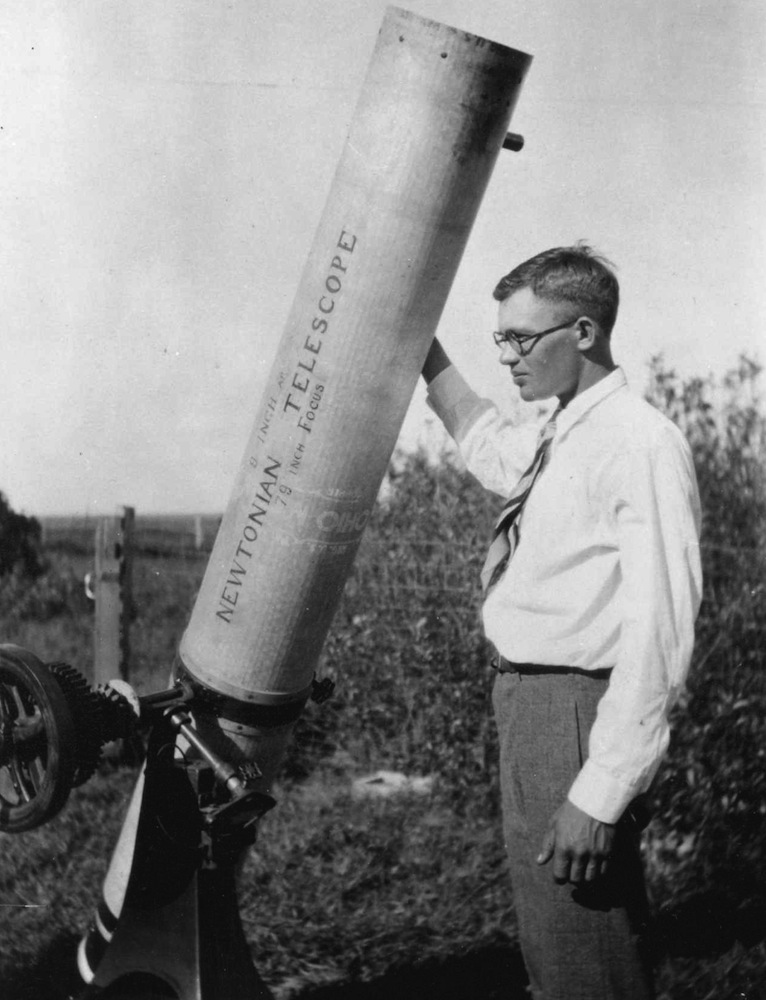
Clyde Tombaugh
Clyde William Tombaugh /ˈtɒmbaʊ/ (February 4, 1906 – January 17, 1997) was an American astronomer. He discovered the ninth planet Pluto in 1930, the first object to be discovered in what would later be identified as the Kuiper belt. At the time of discovery, Pluto was considered a planet, but was reclassified as a dwarf planet in 2006. Tombaugh also discovered many asteroids, and called for the serious scientific research of unidentified flying objects.
"Tombaugh" redirects here. For other uses, see Tombaugh (disambiguation).
Clyde Tombaugh
January 17, 1997 (aged 90)
Discovery of Pluto
Patricia
Annette and Alden
- Clayton Kershaw (great-nephew)
- Matthew Tombaugh
- Richard Tombaugh
- 5 siblings
- Jackson-Gwilt Medal (1931)
- New Mexico State University Board of Regents Medal (1980)
- Rittenhouse Medal (1990)
Early life[edit]
Tombaugh was born in Streator, Illinois, son of Muron Dealvo Tombaugh, a farmer, and his wife Adella Pearl Chritton on February 4, 1906.[1] He was the first of six children in the family with his sister, Esther being born 2 1/2 years after Clyde followed by his brother Roy in 1912, Charles in 1914, Robert in 1923 and Anita Rachel in 1929.[2] Tombaugh's interest in astronomy appears to have begun when he visited the Yerkes Observatory in Lake Geneva, Wisconsin when he was 12 years old in 1918. His uncle Lee also helped spark his interest in astronomy as he was an amateur astronomer who used a 3-inch (76 mm) diameter non-achromatic refractor telescope and gave him several astronomy related books.[3]
The family's poor finances, due to years of bad weather on the farm and a bad corn harvest in 1921, caused them to move to a new farm in Burdett, Kansas in 1922.[4][5] As the family had moved to the farm in August 1922 and the crops needed to be prepared urgently, Tombaugh had to drop out of high school for a year to help his father prepare the crops on the family farm.[6] Tombaugh graduated from high school in 1925.[7] Tombaugh's plans for attending college were frustrated when a hailstorm in June 1928 ruined his family's farm crops.[8][9] Tombaugh read an article in Popular Astronomy in 1924 by an amateur astronomer named Latimer J. Wilson, titled "The Drift of Jupiter's Markings" showing sketches of Jupiter and decided he wanted to make his own telescope so he could see the features shown on Jupiter in sketches.[10][11]
Other ventures[edit]
During World War II he taught naval personnel navigation at Northern Arizona University.[9] He worked at White Sands Missile Range in the early 1950s, and taught astronomy at New Mexico State University from 1955 until his retirement in 1973. In 1980 he was inducted into the International Space Hall of Fame.[41] In 1991, he received the American Academy of Achievement's Golden Plate Award presented by Awards Council member Glenn T. Seaborg.[42][43]
Later life[edit]
Direct visual observation became rare in astronomy. By 1965 Robert S. Richardson called Tombaugh one of two great living experienced visual observers as talented as Percival Lowell or Giovanni Schiaparelli.[44] In 1980, Tombaugh and Patrick Moore wrote a book Out of the Darkness: The Planet Pluto.[45] In August 1992, JPL scientist Robert Staehle called Tombaugh, requesting permission to visit his planet. "I told him he was welcome to it," Tombaugh later remembered, "though he's got to go one long, cold trip."[46] The call eventually led to the launch of the New Horizons space probe to Pluto in 2006. Following the passage of Pluto by New Horizons on July 14, 2015, the "Heart of Pluto" was named Tombaugh Regio.
Personal life[edit]
Clyde Tombaugh had five siblings. Through the daughter of his youngest brother, Robert, he is the great-uncle of Los Angeles Dodgers pitcher Clayton Kershaw.[47]
Tombaugh was an active Unitarian Universalist, and he and his wife helped found the Unitarian Universalist Church of Las Cruces, New Mexico.[48]
Death[edit]
Tombaugh died on January 17, 1997, in Las Cruces, New Mexico, at the age of 90, and he was cremated. A small portion of his ashes was placed aboard the New Horizons spacecraft. The container includes the inscription: "Interred herein are remains of American Clyde W. Tombaugh, discoverer of Pluto and the Solar System's 'third zone'. Adelle and Muron's boy, Patricia's husband, Annette and Alden's father, astronomer, teacher, punster and friend: Clyde W. Tombaugh (1906–1997)".[49] Tombaugh was survived by his wife, Patricia (1912–2012), and their children, Annette and Alden.[50]